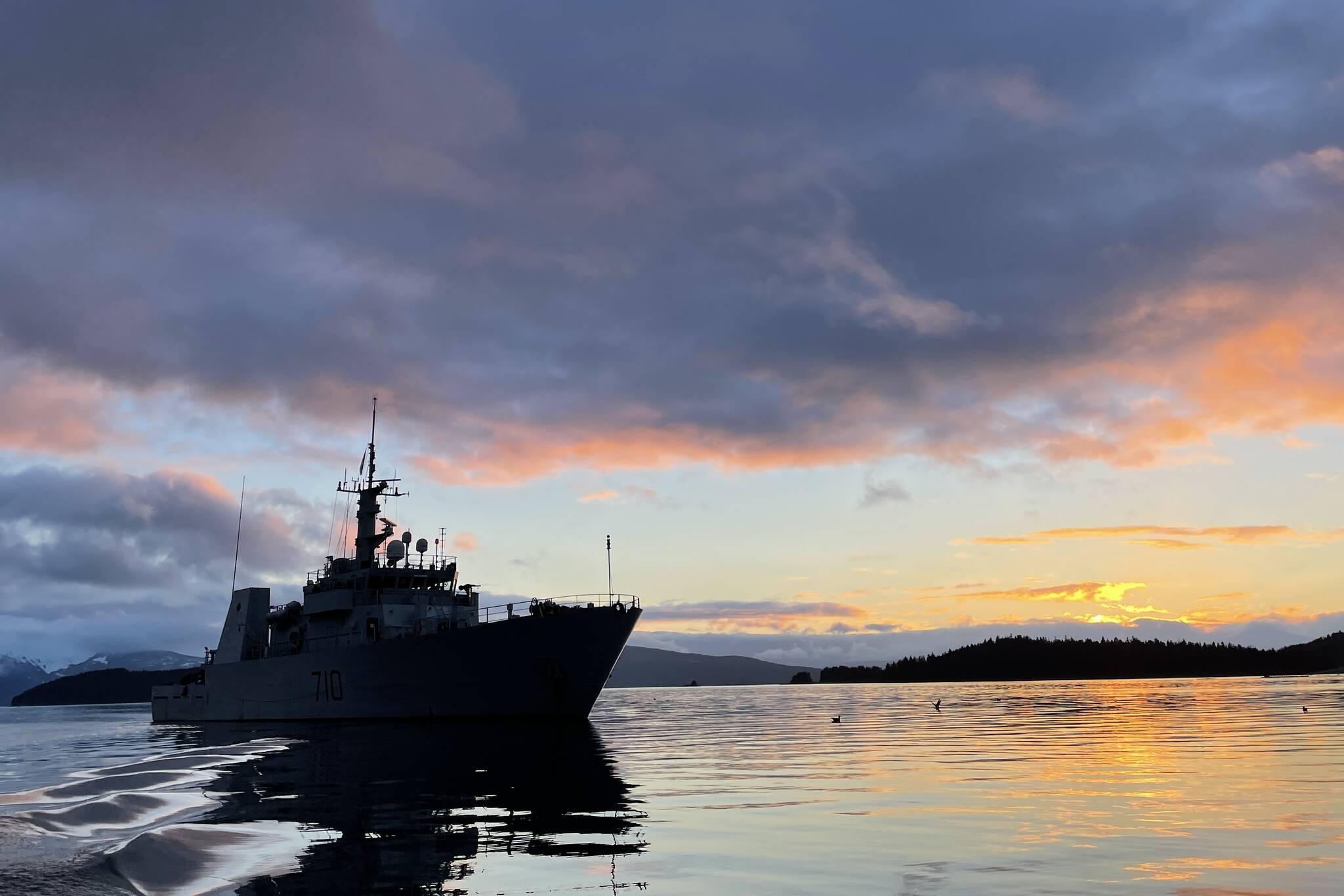Drizzling rain greeted a sullen Sunday morning as a small boat pulled alongside the launch float at Don D. Statter Harbor.
Men in almost-familiar uniforms loaded Pelican cases and other gear about the boat before heading out into the darkness, cruising past the breakwater to a ship illuminated in the hazy pre-dawn by red running lights: Her Majesty’s Canadian Ship Brandon, a minesweeper supporting exercise Arctic Edge 2022.
“For us here, it’s the first time the dive team has participated in exercise Arctic Edge,” said Lt. (Naval) Slava Khabian, a mine countermeasures officer with Fleet Unit Pacific. “It’s great to do things away from home. That way you can really focus on the task at hand.”
The Brandon joins the Army, Navy and Air Force in the biennial exercise as more than a 1,000 servicemembers arrive in Alaska.
“This was the first time I think our navy has participated in this exercise,” said the Brandon’s captain, Lt. Cmdr. Mike Wills, in an interview. “We’re trying to improve our cold weather experience and capabilities.”
[Military holds major Arctic exercise across Alaska]
The ship is employing a remote environmental monitoring units unmanned underwater vehicle to scan the seabed in designated training areas on the other side of Douglas for simulated mines, said Wills.
“I think the U.S. Coast Guard laid the targets. Our primary task is to exercise, essentially using the REMUS to find everything that’s on the bottom,” Will said. “(The target is) shaped exactly like a regular mine.”
The partnerships in the joint exercise allow the RCN to practice new scenarios, Will said.
“The scope is a little bit bigger,” Wills said. “Some of the things we’re doing here, we can’t necessarily do back home.”
The Brandon arrived in Juneau several days ago before heading out to the Stephens Passage, where the training area for the exercise is located.
“The U.S. Coast Guard in particular was very welcoming. We used their dock and their port services,” Wills said. “We’re very fortunate because when we show up everything’s already sorted. If the local community doesn’t support it, this exercise doesn’t happen.”
Safety at sea
Mining a strait, passage or port has long been a warfighting tactic for some countries, said Petty Officer 1st Class Chris Nevue, the REMUS petty officer. Mines were used in the Gulf War, the Kosovo War and other conflicts, Nevue said — Russia, in particular, is suspected to have thousands of mines.
“Mine use is becoming a cheap and effective way of blocking a port,” Nevue said. “The biggest thing is not putting an MCM vessel into a threat area. The autonomous vehicle takes care of that.”
This exercise is the first time his team has taken the REMUS aboard the minesweeper, Nevue said, and a unique opportunity to test the UUV in a colder environment than the unit’s homeport of Victoria, British Columbia.
“Cold weather obviously is an issue. The actual temperature is about 4 degrees Celsius (7.2F) colder than we’re used to in Victoria. It’s a bit windier. Snow, obviously,” Nevue said. “Currents is another one. This particular area has some strong currents. That’s obviously an issue with a battery powered UUV.”
The cold affects the battery by a small but noticeable amount, Nevue said. But despite limitations imposed by the battery, Nevue, it’s still a much safer method of clearing an area suspected to be mined instead of taking the entire vessel into harm’s way.
“The biggest thing is not putting a mine countermeasure vessel into a threat area,” Nevue said. “The autonomous vehicle takes care of that.”
Targets can be difficult to identify, Nevue said, with all the debris that can accumulate on the seafloor.
“All of us really enjoy this job. It’s a really interesting, challenging job,” Nevue said. “Even as good as the sonar images are, it’s hard to pick out what’s a rock or a tree or something.”
Divers below
Once a target is identified with a high degree of confidence, divers will investigate, and if necessary, neutralize a mine, Khabian said. There’s additional challenges that come with the limited space available for staging aboard the minesweeper alongside the dive team’s equipment, including the hyperbaric chamber, a requirement for all dive operations.
“The goal is to take full advantage and do as many dives as possible, weather permitting. In Juneau, the temperatures are the same in March as they are in Victoria in December,” Khabian said. “So far we’ve done four dives.”
For the divers, exercises are an opportunity to compare gear and practice with divers from other militaries.
“The big thing is taking a look at each other’s equipment and how they use it. Sometimes we have kit the Americans are very interested in, sometimes it’s the other way around,” Khabian said. “We were in Ukraine not too long ago and we were demonstrating a different mine lifting technique.”
It’s the dive team’s first time operating off the Brandon as well.
“With expeditionary mine countermeasures, it’s usually a vessel of opportunity,” Khabian said. “We can stage on the shore.”
The exercise is going smoothly, Will said, with several more days at sea before the Brandon will briefly return to Juneau before sailing south to the ship’s homeport in Victoria.
“It’s gone pretty much exactly as planned. The planning phase of it was really quite good,” Wills said. “The U.S. Coast Guard in Juneau did a lot of work to lay the groundwork.”
• Contact reporter Michael S. Lockett at 757-621-1197 or mlockett@juneauempire.com.

